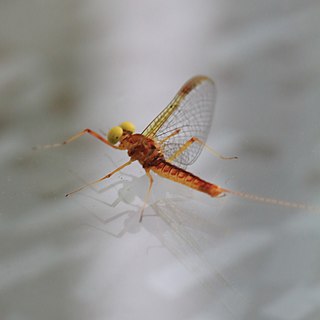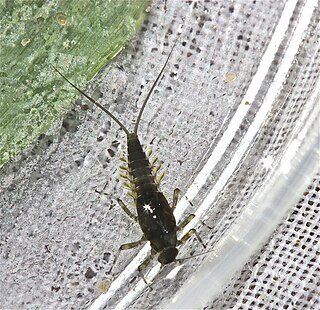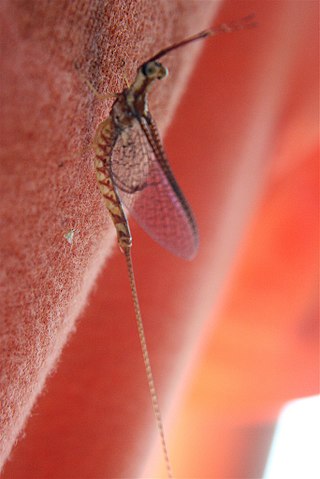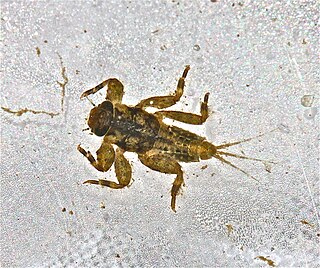
Mayflies are aquatic insects belonging to the order Ephemeroptera. This order is part of an ancient group of insects termed the Palaeoptera, which also contains dragonflies and damselflies. Over 3,000 species of mayfly are known worldwide, grouped into over 400 genera in 42 families.

Baetidae is a family of mayflies with about 1000 described species in 110 genera distributed worldwide. These are among the smallest of mayflies, adults rarely exceeding 10 mm in length excluding the two long slender tails and sometimes much smaller, and members of the family are often referred to as small mayflies or small minnow mayflies. Most species have long oval forewings with very few cross veins but the hindwings are usually very small or even absent. The males often have very large eyes, shaped like turrets above the head.

Ephemerellidae are known as the spiny crawler mayflies. They are a family of the order Ephemeroptera. There are eight genera consisting of a total 90 species. They are distributed throughout North America as well as the UK. Their habitat is lotic-erosional, they are found in all sizes of flowing streams on different types of substrates where there is reduced flow. They are even found on the shores of lakes and beaches where there is wave action present. They move by swimming and clinging, they are very well camouflaged. Most species have one generation per year. They are mostly collector-gatherers.

Pentagenia, similar to Hexagenia, is a genus of insect in the family Ephemeridae, commonly referred to as burrowing mayflies.

Baetis is a genus of mayflies of the family Baetidae, known as the blue-winged olive to anglers. There are at least 150 described species in Baetis. They are distributed worldwide, with the most variety in North America and northern Europe.

Heptagenia is a genus of flatheaded mayflies in the family Heptageniidae. There are at least 20 described species in Heptagenia.

Rhithrogena is a genus of flatheaded mayflies in the family Heptageniidae. There are at least 150 described species in Rhithrogena.

Callibaetis is a genus of small minnow mayflies in the family Baetidae. There are at least 30 described species in Callibaetis.

Heterocloeon is a genus of small minnow mayflies in the family Baetidae. There are about nine described species in Heterocloeon.
Neoephemera is a genus of large squaregill mayflies in the family Neoephemeridae first described by McDunnough (1925). and containing approximately six described species in Neoephemera.

Hexagenia is a genus of mayfly in the family Ephemeridae, the common burrower mayflies.

Baetiscidae is a family of mayflies. It contains a single extant genus, Baetisca, native to North America with around 12 species. The family is noted for their spined armoured larvae, which live in flowing water pools and on the edges of streams where they are detritivores, consuming fine particles of organic matter. Three other extinct genera are known, extending back to the Early Cretaceous. They are closely related to Prosopistomatidae which have unusual, beetle-like nymphs as well as the extinct genus Cretomitarcys, with the three groups constituting the clade Carapacea.

Drunella is a genus of spiny crawler mayflies in the family Ephemerellidae. There are at least 20 described species in Drunella.
Ametropodidae is a family of mayflies in the order Ephemeroptera. There are at least three genera and three described species in Ametropodidae.

Pisciforma is a suborder of mayflies in the order Ephemeroptera. There are at least 410 described species in Pisciforma.

Baetis tricaudatus is a species of small minnow mayfly in the family Baetidae. It is found in Central America and North America. In North America its range includes all of Canada, all of Mexico, and the continental United States.

Ephemerella invaria, the sulphur dun, is a species of spiny crawler mayfly in the family Ephemerellidae. It is found in southeastern and northern Canada and the eastern United States.
Attenella is a genus of spiny crawler mayflies in the family Ephemerellidae. There are at least four described species in Attenella.

Acentrella turbida is a species of small minnow mayfly in the family Baetidae. It is found in Central America and North America. In North America its range includes all of Canada, northern Mexico, and at least 43 of the 50 states within the United States, including Alaska No common name has been given to this insect.
Attenella delantala is a species of spiny crawler mayfly in the family Ephemerellidae. It is found in the western United States.














